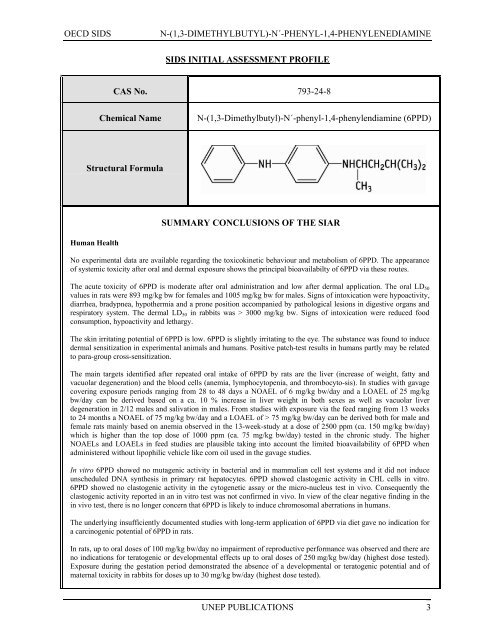N-(1,3-Dimethylbutyl)-N
N-(1,3-Dimethylbutyl)-N
N-(1,3-Dimethylbutyl)-N
Create successful ePaper yourself
Turn your PDF publications into a flip-book with our unique Google optimized e-Paper software.
OECD SIDS<br />
N-(1,3-DIMETHYLBUTYL)-N´-PHENYL-1,4-PHENYLENEDIAMINE<br />
SIDS INITIAL ASSESSMENT PROFILE<br />
CAS No. 793-24-8<br />
Chemical Name<br />
N-(1,3-<strong>Dimethylbutyl</strong>)-N´-phenyl-1,4-phenylendiamine (6PPD)<br />
Structural Formula<br />
Human Health<br />
SUMMARY CONCLUSIONS OF THE SIAR<br />
No experimental data are available regarding the toxicokinetic behaviour and metabolism of 6PPD. The appearance<br />
of systemic toxicity after oral and dermal exposure shows the principal bioavailabilty of 6PPD via these routes.<br />
The acute toxicity of 6PPD is moderate after oral administration and low after dermal application. The oral LD 50<br />
values in rats were 893 mg/kg bw for females and 1005 mg/kg bw for males. Signs of intoxication were hypoactivity,<br />
diarrhea, bradypnea, hypothermia and a prone position accompanied by pathological lesions in digestive organs and<br />
respiratory system. The dermal LD 50 in rabbits was > 3000 mg/kg bw. Signs of intoxication were reduced food<br />
consumption, hypoactivity and lethargy.<br />
The skin irritating potential of 6PPD is low. 6PPD is slightly irritating to the eye. The substance was found to induce<br />
dermal sensitization in experimental animals and humans. Positive patch-test results in humans partly may be related<br />
to para-group cross-sensitization.<br />
The main targets identified after repeated oral intake of 6PPD by rats are the liver (increase of weight, fatty and<br />
vacuolar degeneration) and the blood cells (anemia, lymphocytopenia, and thrombocyto-sis). In studies with gavage<br />
covering exposure periods ranging from 28 to 48 days a NOAEL of 6 mg/kg bw/day and a LOAEL of 25 mg/kg<br />
bw/day can be derived based on a ca. 10 % increase in liver weight in both sexes as well as vacuolar liver<br />
degeneration in 2/12 males and salivation in males. From studies with exposure via the feed ranging from 13 weeks<br />
to 24 months a NOAEL of 75 mg/kg bw/day and a LOAEL of > 75 mg/kg bw/day can be derived both for male and<br />
female rats mainly based on anemia observed in the 13-week-study at a dose of 2500 ppm (ca. 150 mg/kg bw/day)<br />
which is higher than the top dose of 1000 ppm (ca. 75 mg/kg bw/day) tested in the chronic study. The higher<br />
NOAELs and LOAELs in feed studies are plausible taking into account the limited bioavailability of 6PPD when<br />
administered without lipophilic vehicle like corn oil used in the gavage studies.<br />
In vitro 6PPD showed no mutagenic activity in bacterial and in mammalian cell test systems and it did not induce<br />
unscheduled DNA synthesis in primary rat hepatocytes. 6PPD showed clastogenic activity in CHL cells in vitro.<br />
6PPD showed no clastogenic activity in the cytogenetic assay or the micro-nucleus test in vivo. Consequently the<br />
clastogenic activity reported in an in vitro test was not confirmed in vivo. In view of the clear negative finding in the<br />
in vivo test, there is no longer concern that 6PPD is likely to induce chromosomal aberrations in humans.<br />
The underlying insufficiently documented studies with long-term application of 6PPD via diet gave no indication for<br />
a carcinogenic potential of 6PPD in rats.<br />
In rats, up to oral doses of 100 mg/kg bw/day no impairment of reproductive performance was observed and there are<br />
no indications for teratogenic or developmental effects up to oral doses of 250 mg/kg bw/day (highest dose tested).<br />
Exposure during the gestation period demonstrated the absence of a developmental or teratogenic potential and of<br />
maternal toxicity in rabbits for doses up to 30 mg/kg bw/day (highest dose tested).<br />
UNEP PUBLICATIONS 3
















